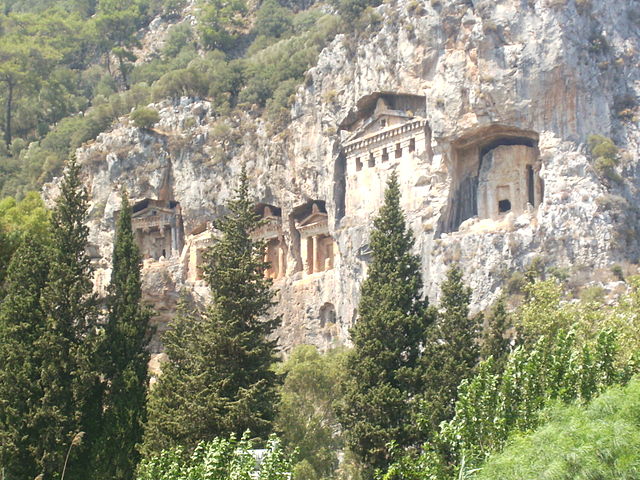Lycia was a historical region in Anatolia from 15–14th centuries BC to 546 BC. It bordered the Mediterranean Sea in what is today the provinces of Antalya and Muğla in Turkey as well some inland parts of Burdur Province. The region was known to history from the Late Bronze Age records of ancient Egypt and the Hittite Empire.
Lycian rock cut tombs of Dalyan
Partial reconstruction of the Nereid Monument at Xanthos in Lycia, c. 390–380 BC.
Inscribed Xanthian Obelisk (c. 400 BC), a funerary pillar for a sarcophagus that probably belonged to Dynast Kheriga.
Lycian rock cut tombs of Dalyan.
The Lycian language was the language of the ancient Lycians who occupied the Anatolian region known during the Iron Age as Lycia. Most texts date back to the fifth and fourth century BC. Two languages are known as Lycian: regular Lycian or Lycian A, and Lycian B or Milyan.
Lycian became extinct around the beginning of the first century BC, replaced by the Ancient Greek language during the Hellenization of Anatolia. Lycian had its own alphabet, which was closely related to the Greek alphabet but included at least one character borrowed from Carian as well as characters proper to the language. The words were often separated by two points.
Xanthos stele with Lycian inscriptions
Payava (his name is Pamphylian) as depicted on his tomb. The Lycian inscription runs: “Payava, son of Ed[...], acquired [this grave] in the sacred [burial] area of the acropolis(?) of A[rttumba]ra (a Lycian ruler), when Lycia saw(?) S[alas](??) [as governor(?)]. This tomb I made, a 10 year [h]iti (project?), by means of Xanthian ahamas.” Payava may be the soldier at the right, honoring his ruler Arttumbara with a laurel wreath. 375-360 BC.
The inscription on the front of Payava's tomb in the Lycian language.
Lycian alphabet: an early attempt at transliteration






![Payava (his name is Pamphylian) as depicted on his tomb. The Lycian inscription runs: “Payava, son of Ed[...], acquired [this grave] in the sacred [bu](https://upload.wikimedia.org/wikipedia/commons/thumb/f/fb/Tomb_Payava_south_BM_950.jpg/640px-Tomb_Payava_south_BM_950.jpg)

